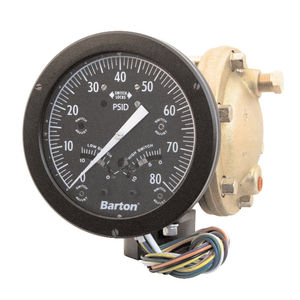
Absolute pressure indicator BARTON 200Adifferentialdialbellows
Add to favorites
Compare this product
Characteristics
- Pressure type
- differential, absolute
- Display
- dial
- Technology
- bellows
- Protection level
- IP65, NEMA 4X
- Applications
- calibration, for liquids
- Other characteristics
- precision, temperature compensated
- Process temperature
Max.: 80 °C
(176 °F)Min.: 1 °C
(34 °F)
Description
Our portfolio of BARTON measurement technology includes differential pressure (DP) indicators that are available for a variety of safe working pressures and DP ranges. They are widely used for the measurement of differential pressure, flow rate, and liquid levels.
Cameron DP indicators are actuated by a rupture-proof-bellows differential pressure unit (DPU) with integral temperature compensation. The BARTON 199 DPU features dual liquid-filled bellows that withstand repeated overranges equal to the safe working pressure of the housings without a change in calibration.
The indicating pointer traverses a 270° arc, providing excellent readability. It is driven by a precision jeweled rotary movement that multiplies rotation of the torque tube through a gear and pinion to the pointer. The movement employs a thermally stable Ni-SPAN-C hair spring. The movement has a micrometer screw for convenient range adjustments. You can make zero and range adjustments without removing the scale plate or pointer. Linearity adjustments are readily accessible after removal of the scale plate.
Features
BARTON technology DPU sensor
Wide selection of DP ranges, including absolute, zero-center, and split ranges
Pulsation dampening
Catalogs
No catalogs are available for this product.
See all of CAMERON‘s catalogsRelated Searches
- Flowmeter
- Volume flowmeter
- Liquid flowmeter
- Pressure transmitter
- Pressure gauge
- Gas flowmeter
- Stainless steel flowmeter
- Analog pressure indicator
- Waterproof flowmeter
- Pressure switch
- Mechanical pressure switch
- In-line flowmeter
- Precision flowmeter
- Compact flowmeter
- Water flowmeter
- Dial pressure indicator
- Mass flowmeter
- Waterproof pressure switch
- RS485 flowmeter
- Ultrasonic flowmeter
*Prices are pre-tax. They exclude delivery charges and customs duties and do not include additional charges for installation or activation options. Prices are indicative only and may vary by country, with changes to the cost of raw materials and exchange rates.



